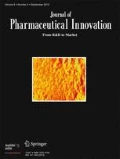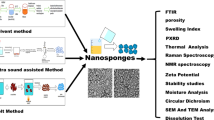Abstract
The aim of this study is to improve the bioavailability of a poorly water-soluble drug glibenclamide (GLB), by preparing drug nanocrystals using wet milling by zirconia beads. To improve the dissolution characteristics, various formulation and process variables were identified and optimized by employing a 32 factorial design at two stages. Based on preliminary studies, the formulation variables selected were polymer-to-drug ratio and surfactant-to-drug ratio and the process variables selected were milling speed and milling time. The particle size, zeta potential, saturation solubility, and percentage drug released at 10 min were selected as dependent variables at both stages. F ratio suggested that the predetermined response parameters were significantly dependent on the independent variables. An optimum desirability of 0.9925 was achieved using response profiler by Statistica® 8.0. The optimized formulation prepared as per levels obtained through desirability showed a close agreement between the predicted and expected values. X-ray diffraction studies concluded that the crystallinity of prepared nanocrystals was intact and the increased dissolution could be ascribed to conversion of unmilled drug to nanocrystals. In vivo studies carried out on male Wistar rats suggested a higher AUEC(0–8h) for GLB nanocrystals as compared to pure GLB which could be ascribed to significant improvement of release from GLB nanocrystals as compared to pure GLB. It could be concluded that prepared GLB nanocrystals showed better bioavailability as compared to pure GLB and could offer improved drug therapy.












Similar content being viewed by others
References
Seedher N, Kanojia M. Co-solvent solubilization of some poorly-soluble antidiabetic drugs. Pharm Dev Technol. 2009;14(2):185–92.
Lindenberg M, Kopp S, Dressman JB. Classification of orally administered drugs on the World Health Organization model list of essential medicines according to the biopharmaceutics classification system. Eur J Pharm Biopharm. 2004;58:265–78.
Otoom S, Hasan M, Najib N. The bioavailability of glyburide (glibenclamide) under fasting and feeding conditions: a comparative study. Int J Pharm Med. 2001;15:117–20.
Hardman JG, Limbird LE, editors. Insulin, oral hypoglycemic agents, and the pharmacology of the endocrine pancreas. 10th ed. McGraw Hill: The Pharmacological Basis of Therapeutics; 2001.
Singare DS, Marella S, Gowthamrajan K, Kulkarni GT, Vooturi R, Rao PS. Optimization of formulation and process variable of nanosuspension: an industrial perspective. Int J Pharm. 2010;402:213–20.
Kumar MP, Rao YM, Apte S. Improved bioavailability of albendazole following oral administration of nanosuspension in rats. Curr Nanosci. 2007;3:191–4.
Mou D, Chen H, Wan J, Huibi X, Yang X. Potent dried drug nanosuspensions for oral bioavailability enhancement of poorly soluble drugs with pH-dependent solubility. Int J Pharm. 2011;413:237–44.
Ghosh I, Bose S, Vippagunta R, Harmon F. Nanosuspension for improving the bioavailability of a poorly soluble drug and screening of stabilizing agents to inhibit crystal growth. Int J Pharm. 2011;409:260–8.
Liversidge EM, Liversidge GG. Nanosizing for oral and parenteral drug delivery: a perspective on formulating poorly-water soluble compounds using wet media milling technology. Adv Drug Deliv Rev. 2011;63:427–40.
Bachhav Y, Patravale V. SMEDDS of glyburide: formulation, in vitro evaluation, and stability studies. AAPS PharmSciTech. 2009;10(2):482–7.
Singh S, Verma P, Razdan B. Glibenclamide-loaded self-nanoemulsifying drug delivery system: development and characterization. Drug Dev Ind Pharm. 2010;36(8):933–45.
Singh S, Srinivasan K, Gowthamarajan K, Singare D, Prakash D, Gaikwad N. Investigation of preparation parameters of nanosuspension by top-down media milling to improve the dissolution of poorly water-soluble glyburide. Eur J Pharm Biopharm. 2011;78(3):441–6.
Shah SR, Parikh RH, Chavda JR, Sheth NR. Application of Plackett–Burman screening design for preparing glibenclamide nanoparticles for dissolution enhancement. Powder Technol. 2013;235:405–11.
Yang JZ, Young AL, Chiang P-C, Thurston A, Pretzer DK. Fluticasone and budesonide nanosuspensions for pulmonary delivery: preparation, characterization, and pharmacokinetic studies. J Pharm Sci. 2008;97(11):4869–78.
Dabhi MR, Limbani MD, Sheth NR. Preparation and in vivo evaluation of self-nanoemulsifying drug delivery system (Snedds) containing ezetimibe. Curr Nanosci. 2011;7:616–27.
Pardeike J, Müller RH. Nanosuspensions: a promising formulation for the new phospholipase A2 inhibitor PX-18. Int J Pharm. 2010;391:322–9.
USFDA, Guidelines. USFDA. http://www.accessdata.fda.gov/scripts/cder/dissolution/dsp_SearchResults_Dissolutions.cfm. Accessed 13 Jan 2009.
Prabu AK, Kumarappan C, Christudas S, Kalaichelvan V. Effect of Biophytum sensitivum on streptozotocin and nicotinamide induced diabetic rats. Asian Pac J Trop Biomed. 2012;2:31–5.
Verma S, Kumara S, Gokhale R, Burgess D. Physical stability of nanosuspensions: investigation of the role of stabilizers on Ostwald ripening. Int J Pharm. 2010;406(1–2):145–52.
Eerdenbrugh BV, Van den Mooter G, Augustijns P. Top-down production of drug nanocrystals: nanosuspension stabilization, miniaturization and transformation into solid products. Int J Pharm. 2008;364:64–75.
Verma S, Huey BD, Burgess D. Scanning probe microscopy method for nanosuspension stabilizer selection. Langmuir. 2009;25(21):12481–7.
Kumar MP, Rao YM, Apte S. Formulation of nanosuspensions of albendazole for oral administration. Curr Nanosci. 2008;4:53–8.
Itoh K, Pongpeerapat A, Tozuka Y, Oguchi T, Yamamoto K. Nanoparticle formation of poorly water-soluble drugs from ternary ground mixtures with PVP and SDS. Chem Pharm Bull. 2003;51(2):171–4.
Acknowledgments
The authors are thankful to Cadila Pharmaceuticals Limited, International Speciality Products, for providing the respective gift samples.
Conflict of Interest
The authors declare no conflict of interest.
Author information
Authors and Affiliations
Corresponding author
Rights and permissions
About this article
Cite this article
Shah, S.R., Parikh, R.H., Chavda, J.R. et al. Glibenclamide Nanocrystals for Bioavailability Enhancement: Formulation Design, Process Optimization, and Pharmacodynamic Evaluation. J Pharm Innov 9, 227–237 (2014). https://doi.org/10.1007/s12247-014-9189-y
Published:
Issue Date:
DOI: https://doi.org/10.1007/s12247-014-9189-y




